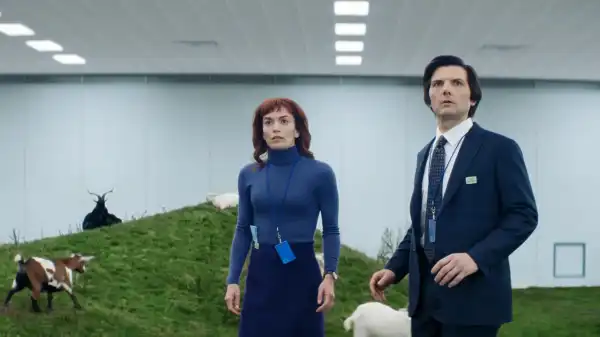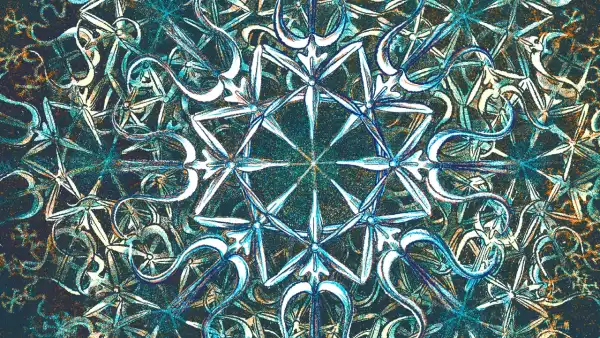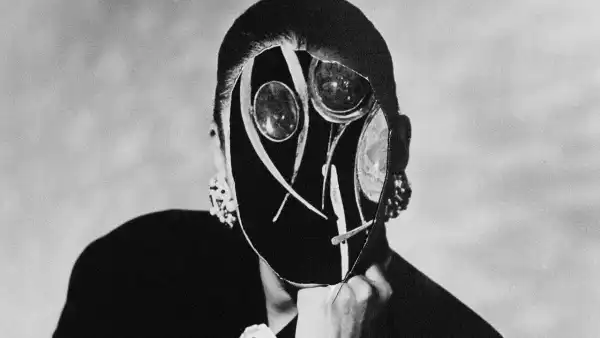
Save this storySave this storySave this storySave this story
When Severance premiered in 2022, it was hailed as an absurdist parable of labor alienation—a dark, sinister critique of technocapitalism that seemed to reflect our age of “upskilling” and AI. The four main characters were employees of Lumon, a cult biotech company. Their department, Macrodata Refinement, forced them to sort numbers every day, filing them in folders based on how creepy they made them feel—a “bullshit job,” in Stephen King’s sense. The basic idea was that each of the main characters had undergone a mind-split procedure that separated their “inner” self from their “outer” self, their life outside of work. They performed their task (whatever it was; they were told only that it was “mysterious and important”) on a “torn floor” whose furnishings echoed popular notions of the white-collar workplace as soulless and abstract: gleaming, empty hallways and uninviting fluorescent lights, retro-futuristic consoles and nausea-colored carpets. The critic Alison Herman described this aesthetic as the “creepy office,” its allusion to the uncanny valley aptly representing Lumont’s campus as an artificial reality, and even as a metaphor for the internet, another dangerously intrusive alternative to real life.
“Severance” pointed out that work was making its protagonists miserable, and that their suffering was tied to some synthetic, dead quality that permeates any circumstance where individuality is suppressed. The Insiders didn’t even have last names; they were identified by their first names and initials: Mark S., Halley R. But the message was confusing, because the characters’ home selves were also miserable. The Outsiders inhabited Kira, the company town named for Lumon’s founder, where “dinners without dinner” were commonplace and it always felt like winter had arrived. They were lonely, static despite their freedom of movement, and existentially empty despite their stores of real experience. The show, which aired on Apple TV+, arrived at the tail end of the pandemic’s work-from-home era, when the office had become a place of angst as much as dread and anger. Many employees were still shuffling numbers into folders as they waited to be called back into the office. They simply carried them out of their apartments, surrounded by dirty dishes and unfolded laundry. The imposed excesses of a tie and the noble disappointments of a broken coffee machine began to seem, if not liberating, then at least somewhat amusing.
At a time when the office seemed glamorous and exotic, The Breakup felt like a war with itself. Whatever the intentions of its creators—most reviews described the show as at least partly a satire of the workplace—what unfolded on our screens was not so much a critique of the office as a fetishization of it. Life on the torn floor was formal in both senses: outwardly polite, ceremonial, and proper; and also mannered, aestheticized, dominated by line, shape, and color (the sharp hem of a woman’s skirt, the stunning red of her hair).
Perhaps Severance was tapping into the post-pandemic zeitgeist by suggesting — counterintuitively, given the show’s premise — that work doesn’t have to be confined to an office to be oppressive. Perhaps the creators wanted to show that work takes over and becomes a brain state, such that only brain surgery can save you. But it seems equally likely that the show was popular because it didn’t actually portray the office as a burden. Rather, Lumon provided its employees with an opportunity to be someone they’re not. On the outside, Dylan (Zach Cherry) seemed like one of the guys. His inner self was a star, and the performance bonuses confirmed it. Mark (Adam Scott) signed up for severance to numb his grief after losing his wife, Gemma. He later learned that Lumon was holding Gemma captive. Everything valuable was concentrated in the office.
The show’s second season, back after a three-year (or, if you’re an introvert reading this, twelve quarters) hiatus, continues to indict the corporate workplace while secretly desiring it. But while the first nine episodes—with their Jobsian visuals and ominous emphasis on data—played up the “tech” side of Lumon’s operations, the new season brings the “biological” side of biotech to the forefront. Nature infiltrates the introverts’ lives in increasingly sinister ways, like when they’re sent into the wilderness for a quasi-religious ORTBO, or Outdoor Retreat and Team Building Occurrence. Elsewhere, the characters stumble across a department called “Mammalies Nurturable,” staffed by gothic cowgirls and a horned hunk who looks like a QAnon shaman. Evolutionary imagery has always been important to Severance, but now the creators seem especially adamant that the office isn’t just a cold, cold place.
Sourse: newyorker.com






